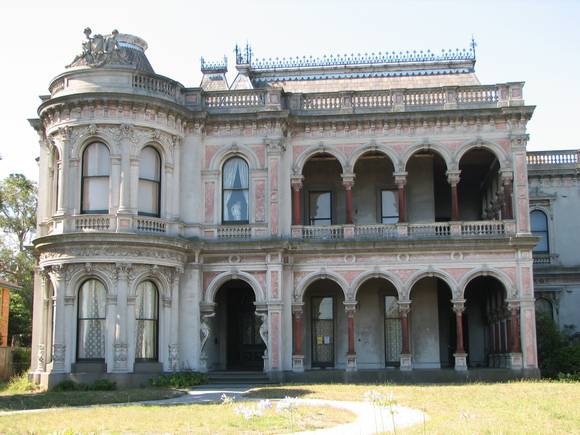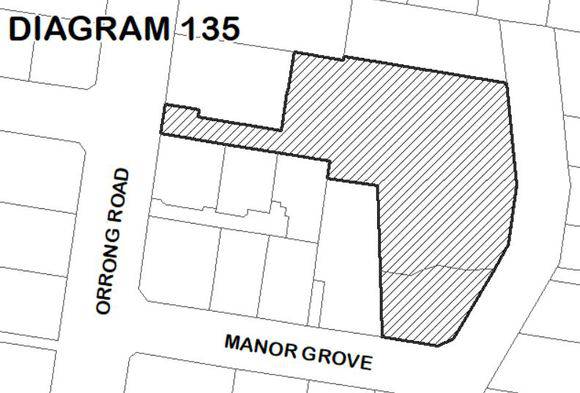| Back to search results » | Back to search page » |
|
LABASSA
Other NamesOntario , Sylliott Hill Location2 MANOR GROVE CAULFIELD NORTH, GLEN EIRA CITY
File Number12/005824LevelRegistered |
|
Statement of Significance
What is significant?
Labassa, Caulfield is one of Melbourne's most lavishly decorated
nineteenth century mansions. It resulted from the extensive
remodelling in 1889-90, of an earlier house, known as Sylliott Hill,
which was begun in 1862-3 for lawyer, Richard A. Billing. The land at
the corner of Balaclava and Orrong Roads was first acquired in 1854 by
William Lyall, transferred to his partner, John Mickle, in 1859, who
also acquired the adjoining allotment in Balaclava Road, and the three
allotments were conveyed to Billing. His first eight-roomed house was
extended significantly in 1873 into a twenty-roomed house by
architects Crouch and Wilson, who were possibly also responsible for
the first house. This reflected Billing's success as a barrister, and
he resided at this property until his death in 1882. In 1883 prominent Melbourne businessman, Alexander William Robertson,
leased the Sylliott Hill property from Billing's widow, and in 1885 he
purchased the adjoining allotment in Balaclava Road. He purchased the
Billing's property in 1887 and renamed the 6.31 hectare property,
Ontario. In 1889-90, Robertson commissioned the German born architect,
John A. B. Koch, to extensively remodel the house into a thirty-five
roomed mansion. The existing house was extended and altered, largely
resulting in the nineteenth century mansion as it now appears. After
Robertson's death in 1896, the house was tenanted until it was
eventually sold to John Boyd II Watson, son of a mining millionaire,
in 1904. He renamed the property Labassa and carried out repair and
re-decoration work to the house. In the early twentieth century, many large estates were subdivided
into smaller allotments as the demand for land grew and it became
difficult to maintain such large estates. After Watson's death in
1911, portions of the Labassa estate were offered for sale, with Mrs
Watson retaining a 1.73 hectare portion containing the house. In 1913
forty-six allotments were auctioned at Labassa Estate, with the
formation of Labassa Grove and Ontario Street to the east of the
property. Labassa was first recorded as containing flats in 1920. In 1936, the
owner, Robert Hannon, built a red brick block of flats adjacent to the
house. Subdivision continued, until the National Trust of Australia
(Victoria) purchased the house in 1980 and subsequently purchased
adjoining sites, one to the south-east in 1984 (house demolished in
1988) and to the west in 1988. Labassa as it now stands is substantially as it appeared when Koch
completed the work in 1890. The original two storey house was
transformed into a French Renaissance style mansion, with the addition
of a two level L-shaped arcaded verandah and two prominent terminating
bays to the south and the east. The building is of unpainted cement
render with dressed bluestone plinths, balustraded parapet and steep,
slate covered, flat topped mansard roofs behind. A truncated conical
roof is a feature of the south bay and a helmeted head is incorporated
in the parapet over the east bay. The main south and east facades
incorporate many cast cement details, including sculptures, elaborate
cornices, swagged Corinthian columns and caryatid consoles flanking
the entrance porch, as well as pink marble panels and imitation
marble, or scagliola, on curved surfaces. At the rear of the building is a two storey wing (built 1873) and a
single storey cottage (1860s), the former being connected to the main
house by a tower. The estate at its peak included stables (1873),
conservatory (probably 1890) and a tennis pavilion (probably 1890).
All of these outbuildings survive, with the conservatory being
converted for residential use, and the stables in 1926. The tennis
pavilion remained in its initial location at 13 Manor Grove, until it
was moved to the mansion gardens in 2014. Internally a range of decorative treatments remain from the late
nineteenth century and the early twentieth century, both from the
Robertson and Watson periods of occupancy. These include wallpapers,
ceiling decoration, chimney pieces, mouldings, joinery and decorative
glass.
How is it significant?
Labassa, Caulfield is of architectural, aesthetic and historical
significance to the State of Victoria.
Why is it significant?
Labassa, Caulfield is of architectural significance as the most
prominent example of a small number of houses built in Australia in
the French Renaissance style. It is of further note due to the German
interpretation of the style and the use of Hellenistic sources, via
Germany. It is exceptional for its lavish treatment externally,
including marble, scagliola, caryatids, swagged columns, mansard roofs
and ornamental cresting. Labassa is of architectural significance as the most important
surviving example of German-born architect, John Koch's domestic work.
He undertook a large variety of work in Melbourne, including a number
of houses, however Labassa is the most lavish example of his work. Labassa is of aesthetic significance for its outstanding assemblage
of late nineteenth and early twentieth century European style interior
decoration, which remain remarkably intact. These include a trompe
l'oeil ceiling, painted ceilings, embossed imitation leather and other
papers, chimney pieces, ceramic tilework, oak parquetry and stained
glass, including a tripartite window by Ferguson and Urie, probably
dating from the 1873 period. Labassa is of historical significance as an illustrative example of
the wealth acquired by a number of prominent Victorian families in the
second half of the 19th century. The early development of the
property, Sylliott Hill, was due to the wealth acquired by Richard
Billing, barrister and fifth Victorian to be appointed Queen's Counsel
in 1878. The significant development in 1889-90 of Ontario is
illustrative of the wealth of Alexander Robertson, a partner in Cobb
and Co., a director of Goldsborough Mort & Co., and a pastoral
speculator. John B. Watson, whose father had acquired great wealth
from the goldfields of Bendigo and subsequently invested in city and
country properties, was the third resident to impact on the house,
particularly the interiors. The Labassa estate is of historical significance as an illustrative
example of the development that occurred in such suburbs as Caulfield
in the 1880s due to the land boom, its proximity to Melbourne and the
establishment of the Melbourne to Gippsland railway in 1879. It is
also illustrative of an estate which succumbed to the pressures of
subdividing in the early twentieth century, as properties became
difficult to maintain and demand for land close to the city grew. It
was typically divided into flats in the 1920s and was used as such for
about sixty years. It is of historical significance for its associations with the
remnants of the earlier estate which remain extant. These include the
stables, conservatory (H2005) and tennis pavilion. Also significant
are the remains of early electrical wiring and fittings. Labassa was
one of the first houses in Caulfield to be electrified and some of the
original wires remain.
Group
Residential buildings (private)
Category
Mansion










